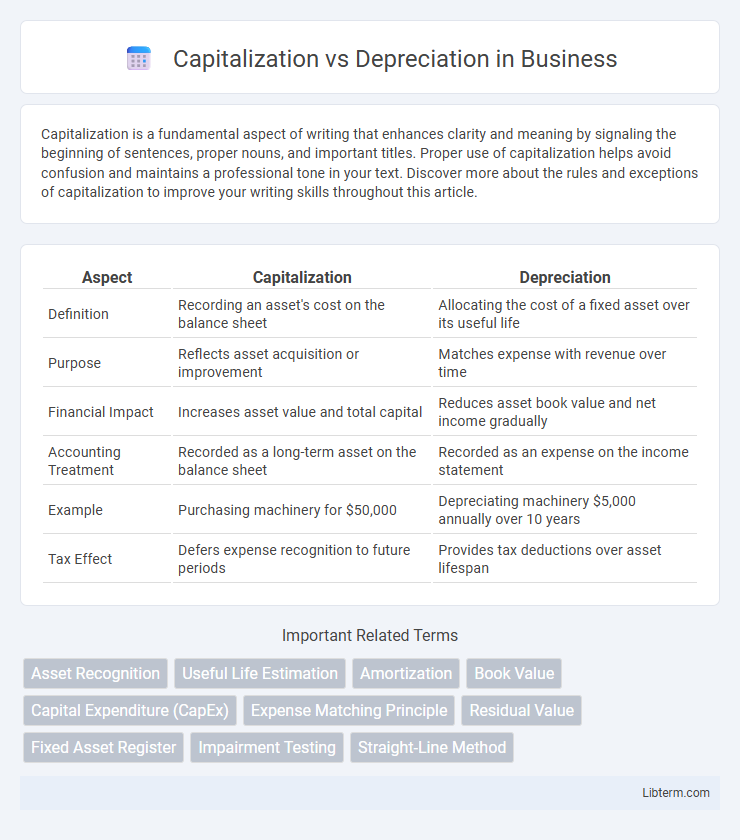Capitalization is a fundamental aspect of writing that enhances clarity and meaning by signaling the beginning of sentences, proper nouns, and important titles. Proper use of capitalization helps avoid confusion and maintains a professional tone in your text. Discover more about the rules and exceptions of capitalization to improve your writing skills throughout this article.
Table of Comparison
| Aspect | Capitalization | Depreciation |
|---|---|---|
| Definition | Recording an asset's cost on the balance sheet | Allocating the cost of a fixed asset over its useful life |
| Purpose | Reflects asset acquisition or improvement | Matches expense with revenue over time |
| Financial Impact | Increases asset value and total capital | Reduces asset book value and net income gradually |
| Accounting Treatment | Recorded as a long-term asset on the balance sheet | Recorded as an expense on the income statement |
| Example | Purchasing machinery for $50,000 | Depreciating machinery $5,000 annually over 10 years |
| Tax Effect | Defers expense recognition to future periods | Provides tax deductions over asset lifespan |
Introduction to Capitalization and Depreciation
Capitalization involves recording a cost as an asset on the balance sheet, reflecting its value over time rather than expensing it immediately. Depreciation systematically allocates the cost of tangible assets like equipment, buildings, or vehicles over their useful life, matching expenses with revenue generation periods. Accurate capitalization and depreciation practices are essential for compliance with accounting standards such as GAAP and IFRS, impacting financial statements and tax calculations.
Defining Capitalization in Accounting
Capitalization in accounting refers to the process of recording a cost or expenditure as a long-term asset on the balance sheet instead of an immediate expense on the income statement. This treatment applies to purchases that provide economic benefits extending beyond a single accounting period, such as machinery, buildings, or equipment. Proper capitalization ensures accurate financial reporting by spreading the asset's cost over its useful life through depreciation, matching expenses with the revenue generated.
Understanding Depreciation: Key Concepts
Depreciation represents the allocation of a capitalized asset's cost over its useful life, reflecting wear and tear or obsolescence. It reduces taxable income by spreading the asset's expense across multiple periods, providing a more accurate measure of profitability. Understanding depreciation methods such as straight-line or declining balance is crucial for financial reporting and tax planning.
Capitalization: Criteria and Examples
Capitalization involves recording a cost as an asset on the balance sheet rather than an immediate expense, meeting criteria such as providing future economic benefits and having a measurable cost greater than a set threshold. Examples of capitalization include purchasing machinery, buildings, or software development costs that extend the company's productive capacity. This approach enhances the financial statements by spreading the expense over the asset's useful life through depreciation, rather than impacting profits in the period incurred.
Depreciation Methods and Their Applications
Depreciation methods determine how the asset's cost is allocated over its useful life, impacting financial statements and tax reporting. Common approaches include straight-line, which spreads cost evenly; declining balance, which accelerates expense in early years; and units of production, aligning expense with actual usage. Selecting the appropriate depreciation method depends on asset type, usage pattern, and accounting objectives to optimize expense recognition and asset valuation.
Key Differences Between Capitalization and Depreciation
Capitalization involves recording the cost of a fixed asset on the balance sheet, spreading the expense over its useful life, while depreciation is the systematic allocation of that asset's cost as an expense over time. Capitalization increases the asset base and impacts the balance sheet, whereas depreciation reduces the asset's book value and affects the income statement through periodic expense recognition. Key differences lie in their accounting treatment: capitalization delays expense recognition, while depreciation ensures gradual expense matching with revenue generated by the asset.
Impact on Financial Statements
Capitalization increases asset value on the balance sheet, deferring expense recognition and enhancing reported profits initially, while depreciation systematically allocates the asset's cost over its useful life, reducing net income annually. Proper capitalization improves key financial ratios like return on assets (ROA) and equity, whereas depreciation affects cash flow indirectly by non-cash expense recognition. Understanding their impact is crucial for accurate financial analysis, tax planning, and compliance with accounting standards like GAAP or IFRS.
Tax Implications of Capitalization vs Depreciation
Capitalization refers to recording an asset's cost on the balance sheet, allowing businesses to spread the expense over the asset's useful life through depreciation, thereby reducing taxable income gradually. Depreciation provides tax benefits by lowering current taxable profits, but capitalization delays immediate tax deductions, impacting cash flow and tax liability timing. Understanding the IRS regulations and depreciation methods, such as MACRS, is crucial for optimizing tax strategies related to capital expenditures.
Common Mistakes and Best Practices
Common mistakes in capitalization vs depreciation include incorrectly classifying expenses, such as expensing capital expenditures instead of capitalizing them, which leads to misstated financial statements. Best practices involve clearly defining asset thresholds and using consistent capitalization policies to separate capital expenditures from operating expenses, ensuring accurate depreciation calculations. Proper documentation and regular review of asset useful lives help maintain compliance with accounting standards like GAAP or IFRS.
Conclusion: Choosing the Right Approach
Choosing between capitalization and depreciation hinges on accurately reflecting asset value and financial health. Capitalization spreads the cost of an asset over its useful life, aligning expenses with revenue generation, while depreciation systematically reduces asset book value to account for wear and obsolescence. Businesses must evaluate asset nature, tax implications, and financial reporting standards to select the approach that optimizes tax benefits and presents a true financial position.
Capitalization Infographic

 libterm.com
libterm.com